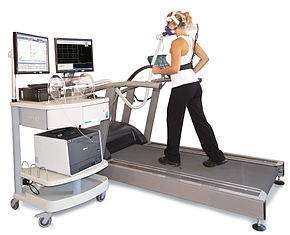A 2-day CPET is a cardiopulmonary exercise test given on two successive days to measure the effect of post-exertional malaise (PEM) on a patient's ability to exercise.[1][2] PEM is a cardinal symptom of myalgic encephalomyelitis/chronic fatigue syndrome and is common in long COVID as well.[3]
| 2-day CPET | |
|---|---|
 A CPET being administered |
Background
editSeveral differences have been found between people with and without ME/CFS, including people with other diseases or who are sedentary. On the first test, people with ME/CFS exhibit lower performance and heart rate, and on the second test, performance is even lower, while for controls, it is the same or slightly better. The largest decrease is in anaerobic threshold, which signifies a shift from aerobic to anaerobic metabolism at a lower level of exertion, and is not influenced by effort.[3][1][4] Peak power output, heart rate, and VO2max also decrease, and in ME/CFS, but effort and familiarity with the test may affect VO2max and power.[5][3] Additionally, healthy people generally recover from a CPET within 24 hours while people with ME/CFS do not.[6]
A 2-day CPET can objectively measure PEM and its effect on physical functioning.[7] (Objective indicators of maximal effort during both tests control for effort.)[7] However, its utility has not been completely confirmed, as many studies of it have been small.[4] While it should not be required for a diagnosis, a 2-day CPET can show that symptoms are not due to deconditioning and provide evidence for obtaining disability benefits.[7] Because PEM is also a symptom of long COVID, the 2-day CPET may be useful in evaluating exercise intolerance there as well.[8]
The cause of decreased performance is not understood. Proposals include impaired oxygen transport, impaired aerobic metabolism, and mitochondrial dysfunction.[3]
The test provokes symptoms by design, and recovery may be prolonged. In some cases, it may worsen the illness long-term.[3][7]
References
edit- ^ a b "Lessons from Myalgic Encephalomyelitis/Chronic Fatigue Syndrome for Long COVID Part 2: Physiological Characteristics During Acute Exercise Are Abnormal in People With Postexertional Symptom Exacerbation". JOSPT Blog. 2022-02-09. doi:10.2519/jospt.blog.20220209 (inactive 1 November 2024).
{{cite journal}}: CS1 maint: DOI inactive as of November 2024 (link) - ^ Joseph, Phillip; Singh, Inderjit; Oliveira, Rudolf; Capone, Christine A.; Mullen, Mary P.; Cook, Dane B.; Stovall, Mary Catherine; Squires, Johanna; Madsen, Kristine; Waxman, Aaron B.; Systrom, David M. (2023). "Exercise Pathophysiology in Myalgic Encephalomyelitis/Chronic Fatigue Syndrome and Postacute Sequelae of SARS-CoV-2". Chest. 164 (3): 717–726. doi:10.1016/j.chest.2023.03.049. PMC 10088277. PMID 37054777.
- ^ a b c d e Franklin, John Derek; Graham, Michael (2022-07-03). "Repeated maximal exercise tests of peak oxygen consumption in people with myalgic encephalomyelitis/chronic fatigue syndrome: a systematic review and meta-analysis". Fatigue: Biomedicine, Health & Behavior. 10 (3): 119–135. doi:10.1080/21641846.2022.2108628. ISSN 2164-1846. S2CID 251636593.
- ^ a b Lim, Eun-Jin; Kang, Eun-Bum; Jang, Eun-Su; Son, Chang-Gue (2020-12-14). "The Prospects of the Two-Day Cardiopulmonary Exercise Test (CPET) in ME/CFS Patients: A Meta-Analysis". Journal of Clinical Medicine. 9 (12): 4040. doi:10.3390/jcm9124040. ISSN 2077-0383. PMC 7765094. PMID 33327624.
- ^ Davenport, Todd E.; Lehnen, Mary; Stevens, Staci R.; VanNess, J. Mark; Stevens, Jared; Snell, Christopher R. (2019-03-22). "Chronotropic Intolerance: An Overlooked Determinant of Symptoms and Activity Limitation in Myalgic Encephalomyelitis/Chronic Fatigue Syndrome?". Frontiers in Pediatrics. 7: 82. doi:10.3389/fped.2019.00082. ISSN 2296-2360. PMC 6439478. PMID 30968005.
- ^ Twomey, Rosie; et al. (2022-02-02). "Lessons from Myalgic Encephalomyelitis/Chronic Fatigue Syndrome for Long COVID: Postexertional Symptom Exacerbation is an Abnormal Response to Exercise/Activity". JOSPT Blog. doi:10.2519/jospt.blog.20220202 (inactive 1 November 2024).
{{cite journal}}: CS1 maint: DOI inactive as of November 2024 (link) - ^ a b c d Beyond Myalgic Encephalomyelitis/Chronic Fatigue Syndrome: Redefining an Illness (PDF). National Academies of Medicine Press. pp. 82–83.
- ^ Durstenfeld, Matthew S.; Sun, Kaiwen; Tahir, Peggy; Peluso, Michael J.; Deeks, Steven G.; Aras, Mandar A.; Grandis, Donald J.; Long, Carlin S.; Beatty, Alexis; Hsue, Priscilla Y. (2022-10-12). "Use of Cardiopulmonary Exercise Testing to Evaluate Long COVID-19 Symptoms in Adults: A Systematic Review and Meta-analysis". JAMA Network Open. 5 (10): e2236057. doi:10.1001/jamanetworkopen.2022.36057. ISSN 2574-3805. PMC 9557896. PMID 36223120.